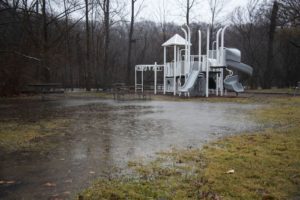It’s a new decade and this is also our 100th News to Us post! To celebrate, we’ve included five articles to keep you abreast on the latest environmental headlines across the Huron, the Midwest, and the US. With 2020 comes a recap on record-setting Midwest precipitation, new developments in research and rulemaking for PFAS, and emerging attacks on national environmental policy.

More than 43 inches or rain and snow: Wisconsin and the Midwest recorded their wettest year ever in 2019
In 2019 the Midwest recorded more than 43 inches of rain and snow, making it the wettest year on record–25% above normal levels. The past decade also marks the wettest on record, with four of the top five wettest years taking place in the past 10 years. These records indicate increasingly intense rainfall events due to climate change.
How to weigh in on Michigan’s proposed limits on PFAS in drinking water
State rules on seven PFAS compounds in drinking water are currently under public review. The Michigan Department of Environment, Great Lakes and Energy (EGLE) welcomes comments from residents until the end of January. Under the proposed rules, municipalities would be required to annually test for the seven PFAS compounds and report higher-than-allowed results. HRWC recently attended one of three EGLE public hearings regarding the proposed rules and provided public comments.
Trump moves to overhaul the National Environmental Policy Act
The Trump administration is proposing changes to the 50-year-old National Environmental Policy Act (NEPA) that narrow its scope. The proposed changes would remove required environmental impact assessments from construction projects, leave communities with less control over these projects, and ax climate change as an environmental consideration. Currently, NEPA requires agencies to analyze the environmental impact of proposed infrastructure and energy developments on water quality, air emissions and endangered species. HRWC is deeply concerned with this proposal and will continue to follow developments related to this issue.
Microplastics may increase the risk of PFAS entering the Lake Michigan food web
A new study by Illinois-Indiana Sea Grant discovered that PFAS can adhere to microplastic particles in water, which increases the likelihood they end up in the food web. While the concentration of PFAS attached to microplastics in the lab setting was quite low, the study hypothesizes that most microplastics in surface waters are at least 10 years old, which would result in more adsorption. Nonetheless, the study is investigating the rate at which fish ingest microplastics and thus the rate at which PFAS enters the food web.
Tracks in the snow | the secret life of wildlife around us
Following winter snowfall, take a look at the ground below you to discover a whole new world into the lives of animals through their tracks. A trail of animal tracks in the snow give us a glimpse into the behaviors and lives of the animals around us. This article provides tips and includes some helpful charts from the Michigan Department of Natural Resources to help you identify the animal by their tracks.



